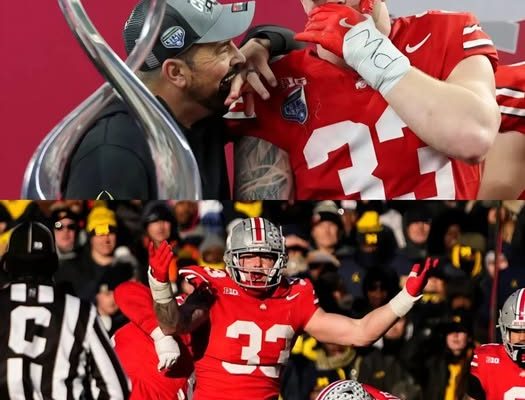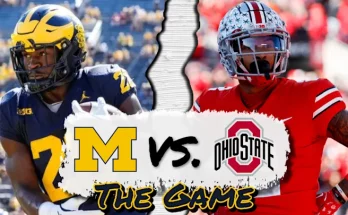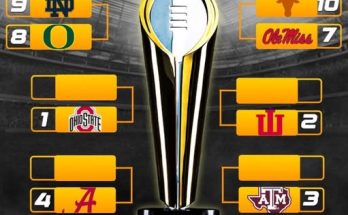Breaking news has once again shaken the world of college football and the professional ranks as former Ohio State Buckeyes defensive end Jack Sawyer has made a surprising move that has reignited discussion about the sport’s most storied rivalry. Sawyer, who once stood as a cornerstone of Ohio State’s fearsome defensive line, is officially returning to the league as a free agent after a short absence. While his decision to come back to professional football has brought excitement to Buckeye fans and NFL observers alike, the headlines became even more compelling after Sawyer was asked about the Ohio State-Michigan rivalry—a topic that has defined much of his athletic career—and he surprisingly chose to downplay its importance in the next stage of his football journey. For a player whose identity has been tied so deeply to the scarlet and gray, this statement carried weight and sparked wide-ranging discussion across the sports community.
Jack Sawyer’s return to the professional football scene comes after a series of ups and downs in his career. Once heralded as one of the nation’s top recruits out of Pickerington, Ohio, he committed early to Ohio State and carried the expectations of being the next in a long line of dominant defensive ends produced by the Buckeyes. He followed in the footsteps of stars like Joey Bosa, Nick Bosa, and Chase Young, all of whom became elite NFL players after leaving Columbus. Sawyer was billed as having the rare blend of size, speed, and relentless motor that defined the Buckeye pass rush tradition. Throughout his collegiate career, he showed flashes of that promise, often disrupting plays in the backfield and earning a reputation as a player who thrived under the brightest lights. His performances against Big Ten competition, particularly in key games that shaped Ohio State’s playoff hopes, cemented him as a player who lived up to much of the hype surrounding him.
However, like many athletes transitioning to the professional level, Sawyer’s path was not linear. He faced challenges with injuries, coaching changes, and the adjustment to the professional game’s increased speed and physicality. These challenges led to a pause in his NFL career, and many wondered if he had played his last snap at the highest level. His return now as a free agent is a statement of resilience, a reminder that elite athletes often refuse to allow their stories to be defined by setbacks. For Buckeye fans, it’s a chance to see one of their own make another push to leave a lasting mark on the sport.
Yet what truly captivated fans and media during Sawyer’s announcement was his commentary on the Ohio State-Michigan rivalry. The rivalry between the Buckeyes and Wolverines is widely regarded as one of the greatest in all of sports, transcending football and representing cultural, regional, and historical divides. Generations of players have embraced the rivalry with an intensity that often defines their careers. Coaches like Woody Hayes and Bo Schembechler built legacies around the annual clash, and modern stars such as J.T. Barrett, Desmond Howard, C.J. Stroud, and Charles Woodson have carried that torch. The “Game” has never been just another game—it’s the measuring stick for both programs, one that influences recruiting, coaching tenures, and even the psyche of fanbases.
Sawyer, however, surprised many by tempering that narrative in the context of his professional career. When asked about his memories of the rivalry and whether those emotions would carry into the next chapter of his journey, he responded with an unexpectedly measured perspective. He acknowledged the importance of the Ohio State-Michigan rivalry during his time in college, recognizing that it was “everything” while he wore the Buckeye uniform. But now, as a free agent looking to carve out a career in the NFL, Sawyer emphasized that the rivalry is no longer his focus. He noted that professional football requires a different mindset, one that prioritizes team goals, personal growth, and adaptability over the traditions that defined college football.
His comments instantly lit up social media. Some Ohio State fans expressed disappointment, feeling that downplaying the rivalry disrespected the decades of tradition that make the Buckeyes’ culture so unique. Others applauded Sawyer’s maturity, understanding that he was making a distinction between his time as a college athlete and his role as a professional. Michigan fans, predictably, seized the opportunity to tease their rivals, joking that even Ohio State’s fiercest warriors eventually move on from “The Game.” Analysts and commentators were quick to point out that Sawyer’s response reflected a broader truth about the transition from college to the NFL. While rivalries are crucial in college football—where traditions and loyalty define much of the experience—the professional game is about survival, performance, and contracts. NFL rosters are built from players across countless rival schools, and success is measured not in rivalry victories but in playoff berths and championships.
Sawyer’s stance also sheds light on the psychological side of sports. Athletes often have to compartmentalize different stages of their careers. For Sawyer, embracing the Ohio State-Michigan rivalry with his entire being was essential as a Buckeye. It motivated him, gave him purpose, and aligned him with the culture of one of the greatest programs in college football. But now, in the NFL, clinging to that rivalry could distract from the new mission: proving himself at the highest level of competition. It speaks to his ability to shift focus, demonstrating that while rivalries can build character, professional athletes must evolve and redefine themselves to thrive in new environments.
Still, Sawyer’s words will not erase the memories of his contributions to the rivalry. He played in several heated clashes against Michigan, games that carried national title implications and tested the resilience of both programs. For Ohio State fans, Sawyer’s sacks, tackles, and intensity during those showdowns will always be part of their memory bank. Those moments defined what it meant to be a Buckeye during his era, and no statement he makes now can diminish their significance. Rather, his comments may simply reflect a broader truth—that rivalries belong to a particular time in an athlete’s journey, and as they move forward, their perspective naturally changes.
Sawyer’s return to the professional game as a free agent also opens fascinating questions about where he might land. Teams in need of defensive line help could see him as a valuable addition, particularly given his pedigree and experience in big-game situations. Coaches know that players forged in programs like Ohio State often carry intangible qualities—discipline, toughness, and the ability to perform under pressure—that make them assets in the locker room and on the field. Whether he lands with a contender seeking depth or a rebuilding team looking for a cornerstone, Sawyer will bring with him the lessons learned from both triumphs and challenges.
It’s also worth noting that his comments about the rivalry may reflect a broader maturity that NFL teams will value. Coaches often stress the importance of focus and professionalism, and Sawyer’s ability to put the rivalry in perspective suggests he is ready to embrace the demands of the professional game. In the NFL, personal vendettas and college allegiances must take a backseat to the business of football. Sawyer’s acknowledgment of that reality may signal his readiness to contribute in a way that transcends the college mindset.
For fans, this story is more than just about a player returning to football. It’s about how sports evolve, how rivalries shape us but do not define us forever, and how athletes must continually adapt to new challenges. Sawyer’s journey from five-star recruit to Ohio State star, to professional struggles, to free agent return mirrors the unpredictable paths that define so many athletic careers. His willingness to downplay the rivalry with Michigan does not mean he disrespects it—it may simply mean he respects it enough to acknowledge that its chapter in his life has closed.
The Ohio State-Michigan rivalry will endure regardless of what any single player says. It existed long before Sawyer and will continue long after him, fueled by the passion of fans, the stakes of competition, and the legacy of those who came before. What Sawyer’s comments remind us, however, is that while rivalries are eternal for programs and fans, they occupy a different place in the lives of the athletes who move through them. For him, the rivalry was a defining feature of his college career, but now, as he seeks to prove himself once more at the highest level, his focus has shifted.
Jack Sawyer’s return as a free agent is an opportunity for redemption, growth, and renewed success. His decision to downplay the Ohio State-Michigan rivalry will continue to spark debate, but in truth, it reveals the reality of the professional journey. For some, rivalries define their legacy. For others, they become fond memories as they step into new arenas. For Sawyer, the story is still being written, and whether he wears scarlet and gray in spirit or simply as part of his past, his impact on both Ohio State and the sport of football will not be forgotten. The next chapter awaits, and with it, a chance to redefine what Jack Sawyer means not just to the Buckeye faithful, but to the world of football as a whole.



